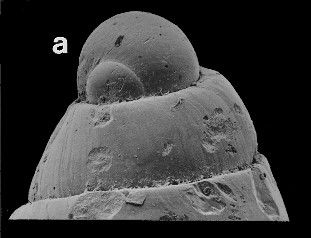
Revised descriptions of New Zealand Cenozoic Mollusca from Beu and Maxwell (1990)

 | Revised descriptions of New Zealand Cenozoic Mollusca from Beu and Maxwell (1990) | 
|
  (Pl. 57a): Evelynella venustas Laws, 1940; GS11185, D45/f8822, Slip Point, Clifden Section, Waiau River (Clifdenian) (apex showing typical pyramidellid heterostrophic protoconch with initial whorl partly hidden by first teleoconch whorl). |
  (Pl. 57e): Evelynella venustas Laws, 1940; GS11185, D45/f8822, Slip Point, Clifden Section, Waiau River (Clifdenian) |
  (Pl. 57f): Evelynella venustas Laws, 1940; GS11185, D45/f8822, Slip Point, Clifden Section, Waiau River (Clifdenian) (oblique basal view showing prominent columellar plait, and internal lirae within aperture). |
Beu & Maxwell (1990): Chapter 17; p. 386; pl. 57 a,e,f.
Classification: Pyramidellidae: Odostomiinae
Description: Height 2.5-4 mm, ovate-conic, spire moderately elevated. Protoconch heterostrophic, low-helicoid, of about 1.5 whorls with partly immersed initial whorl. Teleoconch whorls little-inflated, smooth except for. very fine growth lines and, in some species, spiral striae or 1 or 2 grooves near suture. Columella concave, bearing a single prominent plait near posterior end; outer lip thin, almost straight, lirate within.
Comparison: Evelynella is similar to Odostomia (see below) in overall appearance, but is distinguished by the presence of lirations on the inside of the outer lip.
The Pyramidellidae is one of the most speciose and most widespread of all molluscan families in the New Zealand Cenozoic, and is represented in nearly all molluscan faunules, including those of very shallow-water and bathyal aspects. The checklist includes 175 nominal species (most of them described by Laws) but a large number of additional undescribed species is present in collections. Unfortunately, identification can be difficult as the rather subtle differences between some species are not always very evident from the illustrations given in Laws' papers. It is also not clear from Laws' descriptions to what extent the individual species vary, and it is quite likely that some of the named taxa are superfluous. It is obviously quite impractical to cover all of the numerous genus-group taxa represented in the New Zealand fauna in this account, so Beu & Maxwell (1990) selected several that are likely to be present in washings from fossiliferous horizons.
Laws did not make any attempt to subdivide the Pyramidellidae into suitable subfamilies, but Beu & Maxwell (1990) followed such authors as Abbott (1974, p. 290-309) and Laseron (1959, p. 182-183) in accepting that some subdivision of this large group is desirable. The New Zealand pyramidellids fall into three groups, although it is not clear at present if these are truly monophyletic. The first, the Pyramidellinae, is characterised by relatively large shell size and by having two or three columellar plaits, and is so far known from New Zealand by only a single species (referred tentatively to Pharcidella Dall, 1889) from Altonian shellbeds on the north shore of Parengarenga Harbour. The second group, the Odostomiinae, has a single columellar plait, and includes tail-spired forms such as Syrnola and Tibersyrnola as well as the much shorter-spired taxa Odostomia, Evelynella, Linopyrga, etc. The remaining group, the Turbonillinae, is typically tall-spired and lacks a definite columellar plait, although a strong plait is present in some species currently included in Turbonilla.
Pyramidellids are ectoparasites on other invertebrates, including polychaetes, coelenterates, bivalves and gastropods, but it seems that many species are not host-specific and that others range over the substrate looking for food, rather than remain permanently on their host.
Distribution: Duntroonian-Opoitian, New Zealand, in shallow-water to upper bathyal assemblages.
Cite this publication as: "A.G. Beu and J.I. Raine (2009). Revised
descriptions of New Zealand Cenozoic Mollusca from Beu and Maxwell (1990). GNS
Science miscellaneous series no. 27."
© GNS Science, 2009
ISBN
978-0-478-19705-1
ISSN 1177-2441
(Included with a PDF facsimile file
copy of New Zealand Geological Survey Paleontological Bulletin 58 in CD version
from: Publications Officer, GNS Science, P.O. Box 30368 Lower Hutt, New
Zealand)